Dumb cane (Dieffenbachia) plants are low maintenance and don’t require any special care. Once you understand the growing requirements, you’ll be able to keep your plant healthy and thriving.
Though they aren’t super fussy houseplants, it’s important to understand exactly what they need so you can enjoy the lush foliage for many years to come.
In this complete care guide, I’ll show all you need to know about how to grow Dieffenbachia. You’ll find information about water, soil, light, fertilizer, pruning, propagation, pest control, and much more.
Quick Dieffenbachia Care Overview
| Scientific name: | Dieffenbachia |
| Classification: | Tropical plant |
| Common names: | Dumb cane, Dumbcane |
| Hardiness: | Zones 10+ |
| Temperature: | 65-80°F |
| Flowers: | Green, blooms spring-summer |
| Light: | Full to partial shade, bright light indoors |
| Water: | Allow soil to dry slightly, do not overwater |
| Humidity: | Average to high |
| Fertilizer: | General purpose plant food spring-summer |
| Soil: | Fast-draining, fertile soil |
| Common pests: | Spider mites, thrips, mealybugs |
Information About Dieffenbachia (Dumb Cane)
Dieffenbachia is a very common indoor plant that is prized for its beautiful foliage and simple care requirements. It’s in the Araceae family of plants, and is native to parts of Mexico, the West Indies, and South America.
It earned the nickname, “dumb cane”, because there is a chemical in the sap that can cause temporary loss of speech if any part of the plant is chewed or eaten.
Though they originate from the tropics, they make excellent houseplants because they can quickly adapt to growing indoors.
Different Types Of Dieffenbachia
There are lots of different species and cultivars out there these days, and they’re all gorgeous. You can find dumb cane plants in various sizes and foliage colors too.
Some have large leaves, and can grow to be several feet tall, while others stay much smaller and more compact. The leaf colors vary by type, ranging from dark or bright green with whitish stripes or spots, to almost white leaves with dark edges.
Common varieties you may come across are Seguine, Compacta, Maculata, Golden Sunset, Camilla, or Amoena. Here’s a great list with more options.
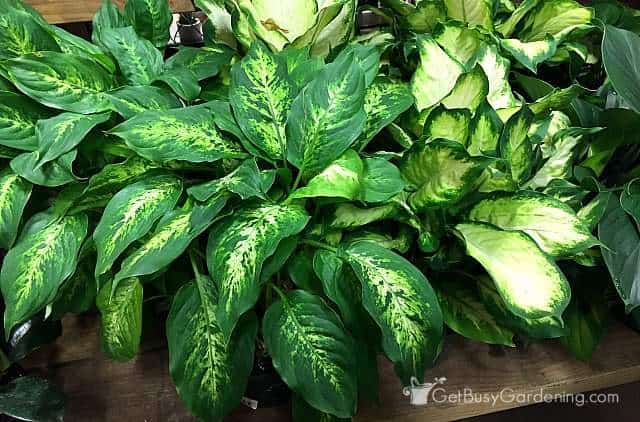
Toxicity
All parts of the Dieffenbachia plant are poisonous when chewed or ingested. According to the ASPCA website, it is also toxic to cats and dogs.
So, if you have animals or small children, then it’s best to keep this plant out of reach, just in case. Check out my list of pet friendly houseplants instead.
Flowers
Though they are best known for their lush foliage, dumb cane plants can also bloom, but the flowers are small and insignificant.
The blossoms are green with a long, white spadix, and tend to appear in the spring or summer. They often blend in with the leaves, so you might not even notice them.
It’s also not very common for a Dieffenbachia to flower indoors. They need the perfect growing conditions, and it can be difficult to get it just right in the average home.
Where To Grow Dumb Cane
Once you bring home a new Dieffenbachia plant, you’ll need to know where to grow it. To have the best success, it’s very important to understand their hardiness and the ideal location.
Hardiness
Dumb canes are not tolerant of the cold, and they will only survive outside year-round in zones 10+. They can handle a very light frost, but if it drops below freezing, the plant will die pretty quickly.
These sensitive plants don’t do well in extremely hot, arid regions either, and prefer a mild, temperate climate. Since they’re so sensitive to any type of extreme weather, it’s usually best to just grow them indoors.
Location
If it’s warm and humid enough where you live, you can grow Dieffenbachia in your garden. Just be sure to choose a shady location where the soil is fertile and well-draining.
Indoors, put your plant in a spot where it will get plenty of bright, indirect light. If you want to move it outside during the summer, bring it back inside before the temperature drops below 60°F.
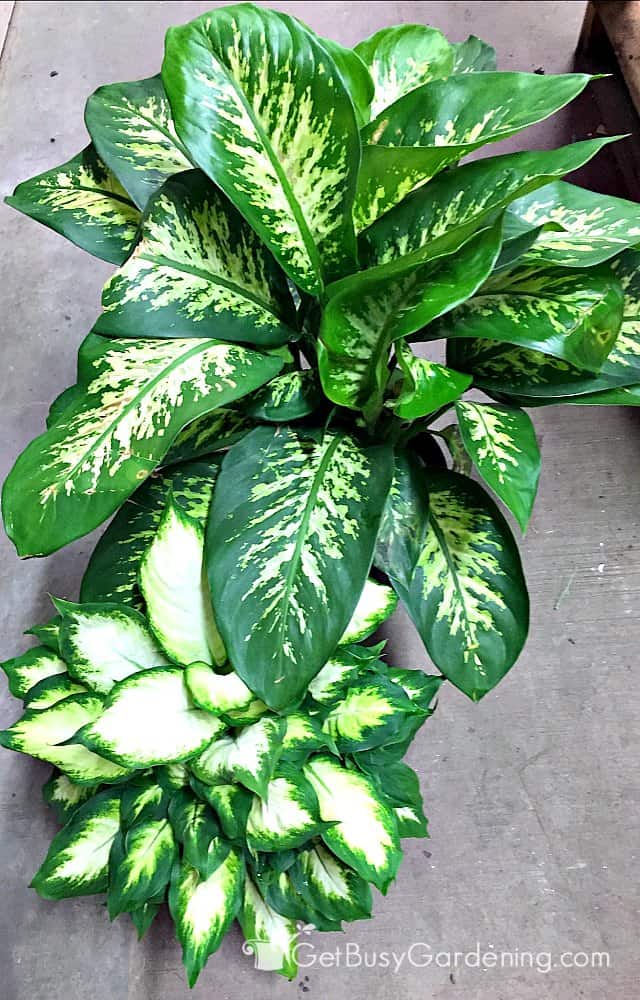
Dieffenbachia Care & Growing Instructions
Even though dumb canes are fairly self-sufficient, they do require some care from you to grow their best. Follow my detailed tips below to keep your plant healthy and thriving.
Water
Proper watering is a crucial part of Dieffenbachia care, and overdoing it is their #1 cause of death. They need consistent, even moisture, but don’t like to be overwatered.
Let the soil dry 1-2″ deep between waterings, but never let it get completely bone dry. Press your finger 2″ into the soil to check the moisture level before giving it more.
The type of water you use is important too. Dumb canes are sensitive to the salts and chemicals found in tap water, which can cause the leaf edges and tips to turn brown. So it’s best to use distilled or rainwater.
When it’s time, give your plant a good soaking until the water starts to run out of the drainage holes. Then allow the excess to completely drain from the pot. If you struggle with this, I recommend getting an inexpensive moisture gauge to help you out.
Humidity
Since they are from the tropics, dumb cane plants really like high humidity. Though they adapt well to lower levels, if it’s extremely dry, the leaf tips and edges can start turning brown.
So if yours constantly has brown leaves, tips, or edges, then try running a humidifier nearby or misting your plant to see if that fixes the problem.
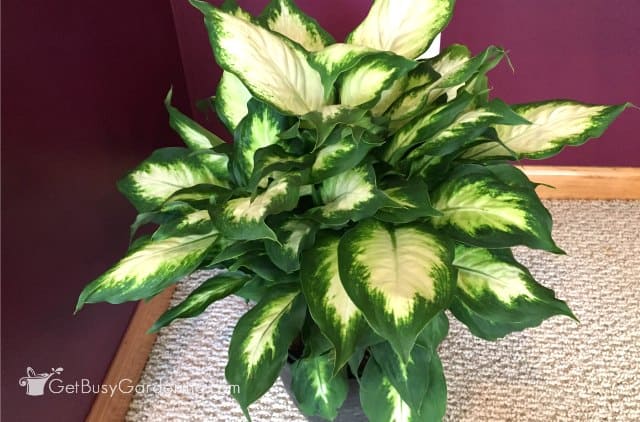
Light
Dieffenbachias are the perfect low-light houseplants because they like the shade, and direct sun will cause their leaves to fade or burn. But if it’s too dark, they’ll quickly grow tall and leggy.
Indoors they need bright, indirect light. A spot next to a sunny window, or an area where your plant will get filtered light through a curtain or blinds would be perfect. If you don’t have a bright room, then you could use a small grow light.
It also helps to rotate the plant once in a while to prevent it from reaching to one side as it grows taller. I rotate mine every time I water, or monthly (or whenever I remember).
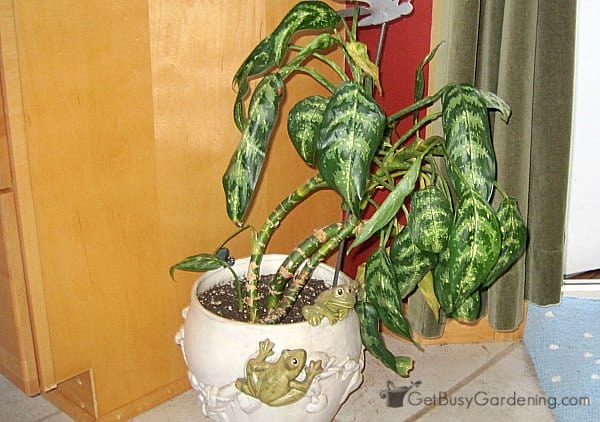
Soil
Dumb canes aren’t super fussy about the type of soil you use, any high-quality general purpose potting mix will work just fine. But they do prefer a porous and well-draining medium.
So, if you tend to overwater, then you’re better off using a fast-draining mix. Or you could add some perlite, pumice, or coarse sand to the potting soil to improve drainage.
Repotting
You don’t have to worry about repotting your Dieffenbachia very often, they don’t need it until they’re pot-bound.
You’ll know it’s time when you see roots coming out of the bottom holes, if there are more roots than soil in the container, or if you have to water your plant constantly to keep it from drooping.
Always use a container with holes in the bottom, and only go up one or two pot sizes. If you give it too much room, your plant may have a difficult time becoming established in the new container.
Related Post: When & How To Repot Houseplants
Fertilizer
Another great thing about dumb canes is that they can grow just fine without fertilizer. But they will benefit from being fed during the spring and summer, and it could even trigger blooming.
However, they are very sensitive to chemicals. Overuse of synthetic fertilizers can lead to brown leaf edges and tips, among other issues. So I highly recommend using an organic one instead.
Apply a diluted, liquid houseplant fertilizer or a compost tea monthly, or you can add slow-release granules once in the spring. Stop feeding in the fall and winter to let your plant rest.
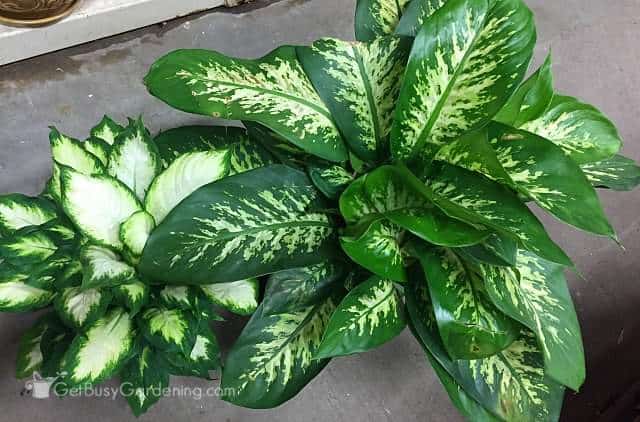
Pest Control Tips
It’s rare for a healthy Dieffenbachia to have problems with bugs, but sometimes spider mites, thrips, or mealybugs can attack them.
If you find bugs, begin treating your plant right away. My favorite product to use is neem oil. It’s a natural insecticide that’s very effective at controlling houseplant pests.
Organic insecticidal soap also works well to knock down an infestation quickly. I make my own by mixing 1 teaspoon of mild liquid soap per 1 liter of water.
Related Post: How To Get Rid Of Houseplant Bugs Naturally

Pruning
Pruning is an important part of Dieffenbachia care, and you should do it regularly. It helps to keep your plant tidy, compact, and healthy. Here are my tips:
- Remove dead or dying leaves and flowers at any time by simply cutting them back to the main stem.
- Trim off brown leaf tips and edges as necessary, following the natural shape of the leaf.
- Clip new growth at the tips every spring to prevent legginess, and encourage your plant to grow more compact and bushy.
- If your dumb cane has grown tall and leggy, you can top the plant, or cut it back anywhere on the stem. New leaves will form just below the spot where you made the cut.
Dieffenbachia Propagation Methods
You can propagate your dumb cane from either stem cuttings or by division. If there are several stems growing in the pot, you can separate them to make new plants.
Rooting cuttings can be a bit tricky. The key is to provide lots of humidity, and keep the soil moist but never soggy.
Take a stem cutting that’s at least 4″ long, and dust it with rooting hormone. Then plant it in a loose, porous soil mix. You’ll know it’s rooted when you see new leaves developing on top.
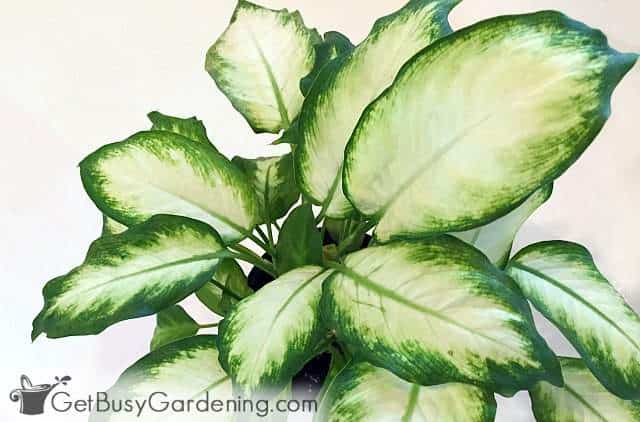
Troubleshooting Common Dieffenbachia Problems
The most frustrating part about Dieffenbachia care is when your plant is sick, and you don’t know why. Below are some of the most common problems you might run into, and tips for how to fix them.
Brown Leaf Tips Or Edges
Brown leaf edges and tips are usually caused by inconsistent watering, low humidity, or salt and chemical buildup in the soil from using tap water or synthetic fertilizers.
Crusty buildup on the top of the soil or around the inside of the pot are signs of overfeeding or too much salt/minerals from tap water. Switch to an organic fertilizer, and use filtered water or rainwater.
Drooping Leaves
When the leaves or the whole plant start drooping, it’s usually caused by over or under watering. But it could also be from exposure to cold or hot air, plant bugs, or transplant shock after repotting.
Leggy Dieffenbachia
Dieffenbachia naturally gets leggy over time, it’s their normal growth habit. But it can be worse if your plant isn’t getting enough light, so move it to a brighter location. You can also prune the tips regularly to encourage bushier growth.
Yellowing Leaves
It’s normal for the lower leaves to turn yellow or brown, and eventually die. Simply trim them off as needed. However, if several of them are yellow, or they aren’t on the bottom, then it’s probably overwatering, insufficient light, pot-bound roots, or bugs.
Inspect the leaves for any signs of an infestation, and then check the soil moisture level. It should never feel soggy or overly wet. If it’s not those things, then make sure your plant is getting bright, indirect light, and check to see if it needs to be repotted.
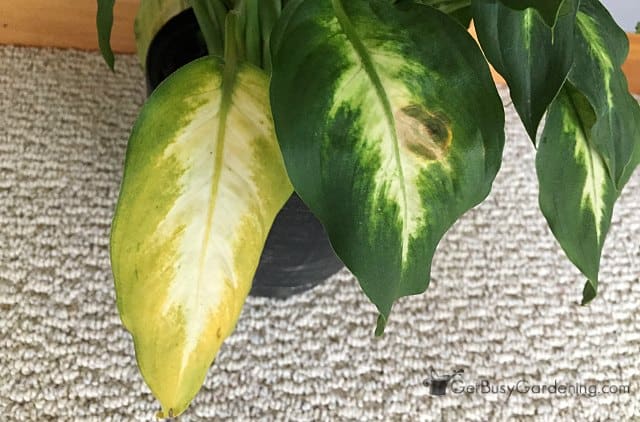
Now that you know how to properly take care of your Dieffenbachia, you’ll be able to grow these gorgeous houseplants for many years to come.
If you want to learn all there is to know about maintaining healthy indoor plants, then you need my Houseplant Care eBook. It will show you everything you need to know about how to keep every plant in your home thriving. Download your copy now!
Share your Dieffenbachia care tips in the comments section below.
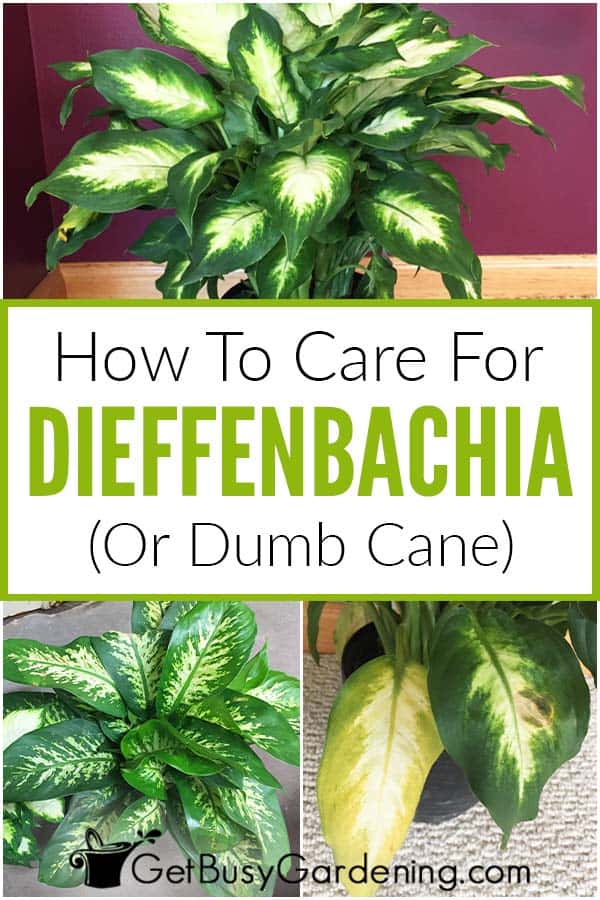
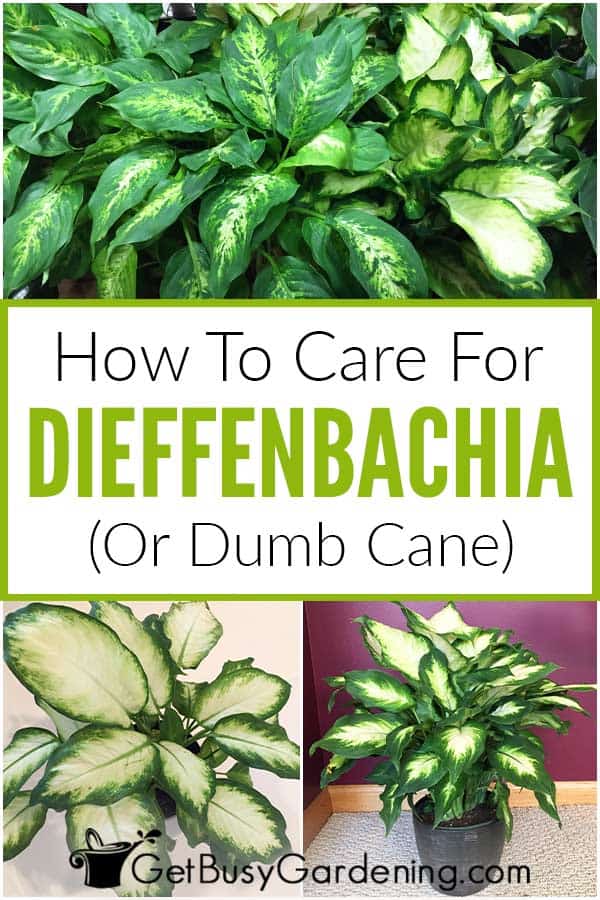

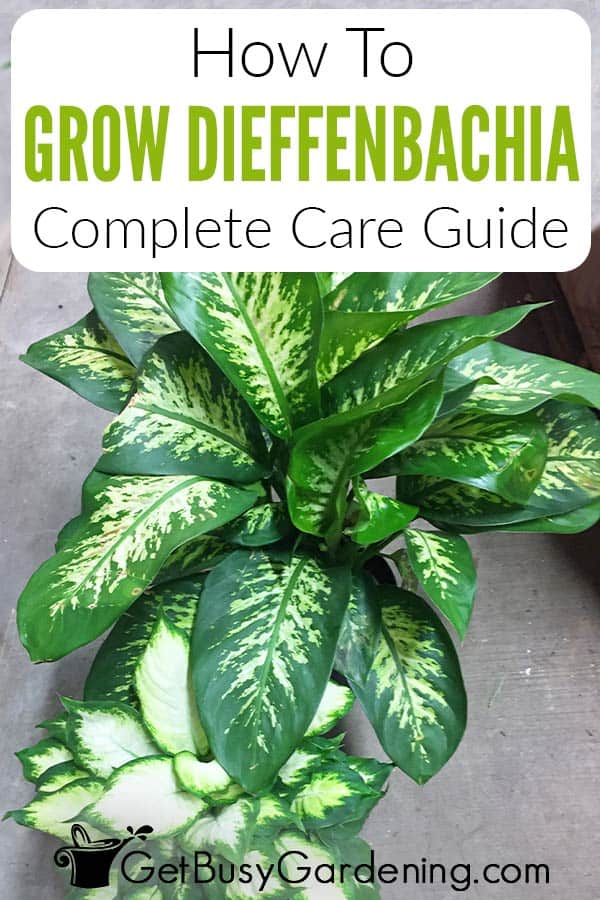

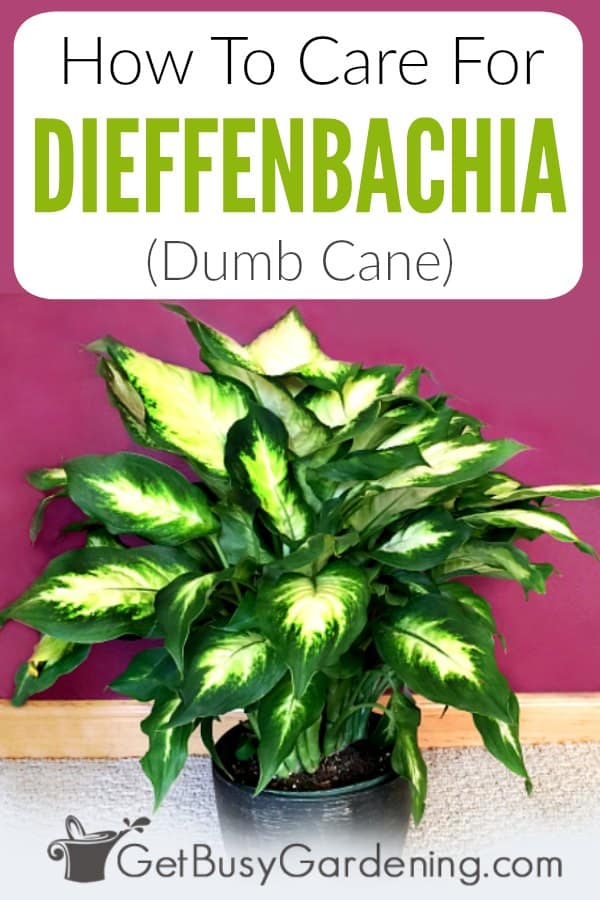
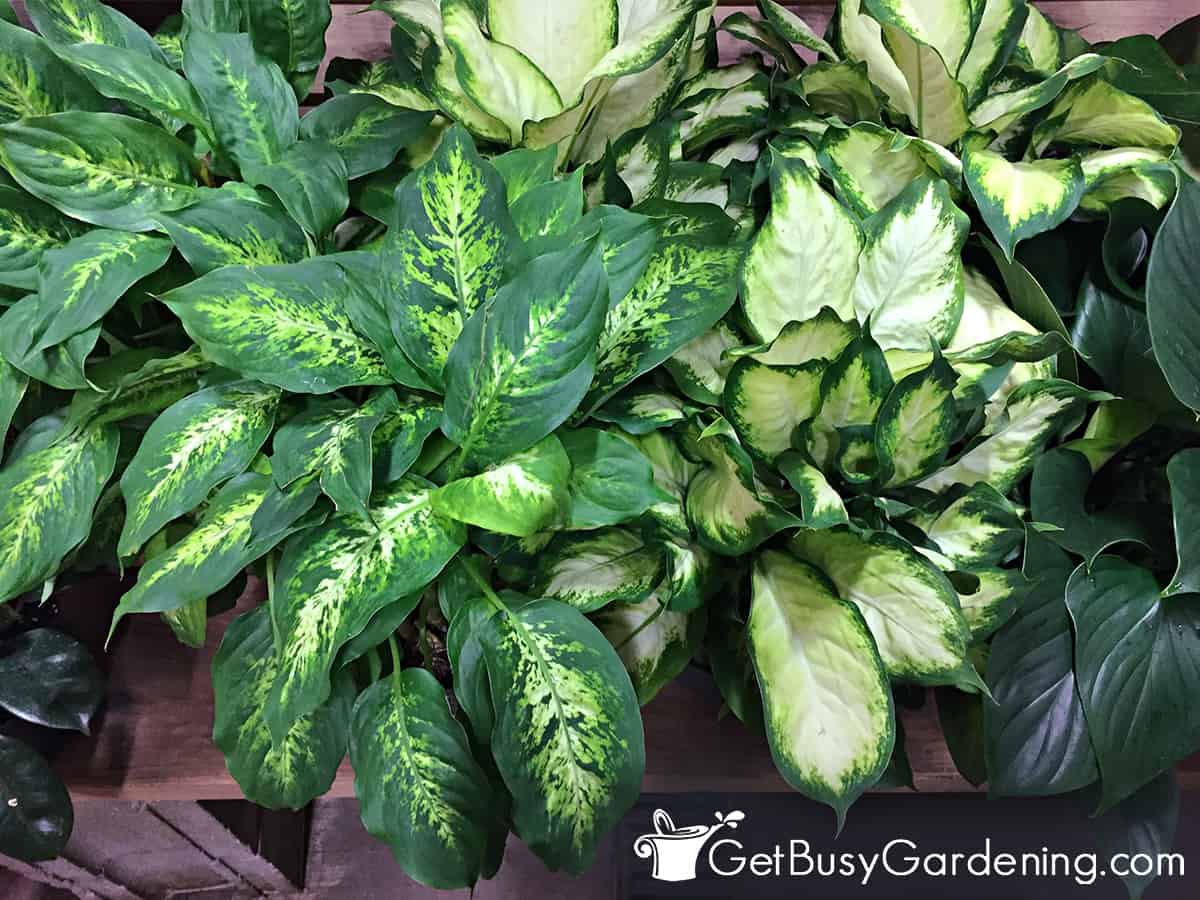



Debiann says
From my experience, water propagation was very easy and fast. My DC became leggy 2 years ago. I was still new to houseplants back then and thought I had killed it. I chopped off the top of the stems (4 stems with about 10 leaves between them) and for the heck of it, I put them in a water tumbler, placed them in a spot with brighter light and forgot about them. About 4 weeks later I checked to see if it needed new water and found the tumbler full of roots. Roots appeared all along the stems, not just at the cut lines, and I didn’t use root hormones. I now have a very full, very lush bush and have propagated a second plant from it.
Amy Andrychowicz says
Oh how wonderful! Thanks so much for sharing your experience with chopping off the top of your dieffenbachia and getting it to root. Congrats, and enjoy your healthy new plants!
Anthony says
My D.C. took a long time to grow a 3rd leaf, but finally when it did, i pinched that one, and now in the middle of Summer leaves are coming out much faster and bushier, the way i prefer. Is there a way to upload a photo here? BTW, so top cutting seem to apply to only leggy plants, i would think.
Amy Andrychowicz says
Awesome! Yes, cutting off the entire top of the plant is only necessary for really leggy dumb canes. But you can pinch out the new growth on top to help keep it bushier. You can’t upload pics here, but you could post it on our Facebook page if you’d like. 🙂
Diane Christofferson says
My dumb cane is about 5 ft tall and looks like a tree. It has leaves on the top 2 feet with a bare “trunk” on the bottom. Recently fresh shoots started coming out of the soil around the bottom of the plant. Does this mean I should cut the top off? I just repotted the plant about 4 months ago.
Amy Andrychowicz says
You don’t have to top your dumb cane if you’re happy with the way it looks. However, if you want it to grow fuller and not be so leggy, then yes, you can cut the top off.
M says
I made a mistake rooting stems that are too long, so now my new plant is leggy to begin with. What should I do?
Amy Andrychowicz says
If you’re brave enough, I would try topping your new dieffenbachia and rooting it again. That is the only way to fix the legginess.
Anthony says
In regard to another ;matter I finally got my D. to come up with 2 more leaves after months waiting if I ever would get any. Now, I want my D. to get bushy, not tall and straggly….do I start by cutting off the latest leaf that showed up and continue to do so with each new leaf or do i let one go by till the next one that i will prune off?
Amy Andrychowicz says
Pruning off the healthy leaves won’t prevent your dieffenbachia from growing tall and leggy, that will only make it worse. The only way to get them to get bushier is to top the plant, and then keep it pruned. Cutting off the top can be scary, but you can try rooting the cutting for a new plant! 🙂 Good luck.
Anthony says
I’m confused by ‘topping’ feature. Just what is topping mean and how is it handled with a plant that is finally showing some growth after months waiting? My plant has only 2 major leaves and another one appearing slightly in the center. I already had pruned the previous new growth and now this one is appearing.
Amy Andrychowicz says
Topping a plant means cutting off the whole top of it. That method works well for an established dieffenbachia plant that has been growing tall and leggy for several years. However, it sound like yours is recovering from some sort of trauma that made it lose all or most of the leaves. So in this case, I wouldn’t cut off any of the leaves or top it right now. I would let it recover and grow several healthy leaves again. Once it has several (I don’t know, maybe 8-10) sets of leaves, then you could prune off the very tip of the central stem to get it to branch out on top. However, that will not make new leaves grow on the bottom/bare stem. With dieffenbachias, the only way to get it to be short and bushy again is to top the whole thing. So, that means cutting the main stem back 4-5 inches below the last set of leaves. Them you would propagate the stem you cut off, and wait for the remaining empty stem to grow again. But topping your plant now before it has many leaves might just end up killing it. Hopefully that makes more sense.
Mark Cousins says
Amy, just FYI, “dumb” originally was used to refer to those who are unable to speak. It was not and is not slang, and the original inference was not unkind … just factual. It now means both “unable to speak” and “unintelligent” with the latter use far more common.
You can see this a bit in our word “dumbfounded” which refers to a person who is at a loss for words, but is not a comment on their intelligence.
Hence the name of the plant. Ingesting the sap will make you (temporarily) unable to speak, dumb. This isn’t a slur, just at statement of fact. It isn’t “mean.”
Jen says
Yes! Thank you! Came here to say this, but you summed it up perfectly.
Tanya says
My plant is 8ft tall but the stems are so thin that it can’t support. Does anyone have and idea of how to thicken the stem? It has been given to me after being cut many times.
Amy Andrychowicz says
When dieffenbachia grows tall and spindly like that, it means it’s not getting enough light. I would move it to a brighter location for starters. Unfortunately, there’s no way to thicken the stems that are already leggy. The only thing you can do is to prune it back. Once it gets enough light, the new growth will be much thicker and stronger.
Reeree says
My dieffenbacia is really green and healthy looking but I noticed The nodes on its stem are yellow? Is that normal?
Amy Andrychowicz says
It depends. If the stem nodes are more brown than yellow, that’s normal. That’s basically just a scar that’s left after the leaves drop off. However if they are truly yellow, then check the soil to make sure you aren’t overwatering. It should be fairly dry before you water again. Stick your finger at least one inch into the soil. If it’s wet, then you may be overwatering. Let it dry more before you water again. Also, make sure it’s in a pot that has drainage holes, so the excess can fully drain from the pot.
Dawn says
My dieffenbachia has performed well for years but now it is droopy and new leaves take a long time to unfurl. I’m not an overwaterer.
Amy Andrychowicz says
When dieffenbachia leaves don’t unfurl, it could be caused by a few things. Mainly improper watering (either over OR under watering), over fertilizing, or a bug infestation. First, take a close look at the leaves to see if you can find any bugs. If that’s not the problem, then check the soil moisture level. If it’s really dry, try watering it a bit more often. Also, check to make sure it’s not completely pot-bound. It could just be that it has outgrown it’s pot, and is ready for a new one.
Tanja DuVall says
Hi our big old Dieffenbachia two of its largest legs froze where do we cut at to take them off?
This was my sisters that passed, plant the plant is at lest 25 yrs old.
Amy Andrychowicz says
If your dieffenbachia stems froze, but the tops are still healthy, then you can take cuttings right above the damaged area and try rooting them. Just make sure you cut off all of the damaged parts of the stem, or the cuttings could rot. Good luck!
Lisa Baltes says
My stems are thin and growing like an ivy. What am I doing wrong?
Amy Andrychowicz says
When dieffenbachias grow thin and leggy like you describe, that means they aren’t getting enough light. Move it to a spot where it gets bright, indirect sunlight, or add a grow light.
Anthony says
How do you manage to have your dumb canes so bushy. Mine are always tall and straggly. i water once a week at a bright south window, no fertilize. its winter now, I thought that they go dormant indoors, but it looks like I have to repot to a larger container. Is that ok for a dormant so called plant?
Amy Andrychowicz says
It’s very common for dumb canes to get tall and leggy with age, this is their normal growth habit. Regular pruning is the only way to keep them compact and bushy. Read the section above titled “Dieffenbachia Pruning Tips” to learn more about that. But don’t prune them during the winter, wait until early spring, otherwise it can trigger weak new growth. I also recommend waiting until early spring to repot it, but only if it really needs it. Dumb canes like to be pot-bound, so don’t repot it unless it’s necessary. The section above titled “Repotting Dieffenbachia Plants” will give you more details about that. Good luck!
Trevor Pass says
Hi Amy, my plant has several leaves that are brown and dry (though not too much curling). I don’t think it’s a watering frequency issue and I haven’t added any fertilizer to the plant since we purchased it a few months ago. The stems feel firm as well. What next steps would you recommend? Distilled water? Would spraying it down with water help (maybe it’s too dry?) I’m a new aspiring green thumb and would love your advice. Thanks!
Amy Andrychowicz says
Oh bummer, sorry to hear your dieffenbachia leaves are turning brown! The first thing to do is check the location. Is it getting too hot or burned in a sunny window, or touching the freezing cold glass at night? Next, take a close look at the leaves to make sure you don’t see any bugs, webbing, or tiny mites. Last, switch to watering it with distilled water or rainwater. Chlorine, softener salt, or other chemicals in tap water can cause this type of damage. If you’ve ruled out all other problems, then try running a humidifier near it to see if that helps.
Linda S Cohen says
My Dieffenbachia has two brown shoots growing out of it. They look like pods. This plant is a cutting from other plants going back 27 years. At present I have seven plants of various sizes. The plants grow like weeds and i am constantly cutting and replanting when they reach the ceiling But, I have never had a brown shoot. what could it be? Should i just leave it?
Amy Andrychowicz says
It sounds to me like they may be flowers. Sometimes dieffenbachia flowers can be so inconspicuous that you don’t notice them until after they have turned brown. Yes, you can just cut the flower steam off down to the base once it’s brown a wilted.
Myra Geffon says
My giant dumb cane will only get 5 leaves and the lowest leaf will then turn yellow and droop. I remove it. It’s in a south facing window but only gets very bright light; not direct sun. I’m not overwatering or over feeding. HELP!
Amy Andrychowicz says
It’s normal for the lower leaves of dumb canes to turn yellow and drop off with age. So, as long as it’s healthy otherwise, then this is just part of their normal growth/aging process. 🙂
Debbie says
I have a small stem of a dumb cane plant I rooted in water and I want to put in a pot what kind of soil would you-recommend this is the only piece I have left from a big dumb cane
Amy Andrychowicz says
Dumb cane will grow just fine in a general purpose potting soil. However, if you tend to over or under water plants, then you might want to make a few modifications to the mix. Read the section above titled “Dieffenbachia Soil Requirements” for more details.